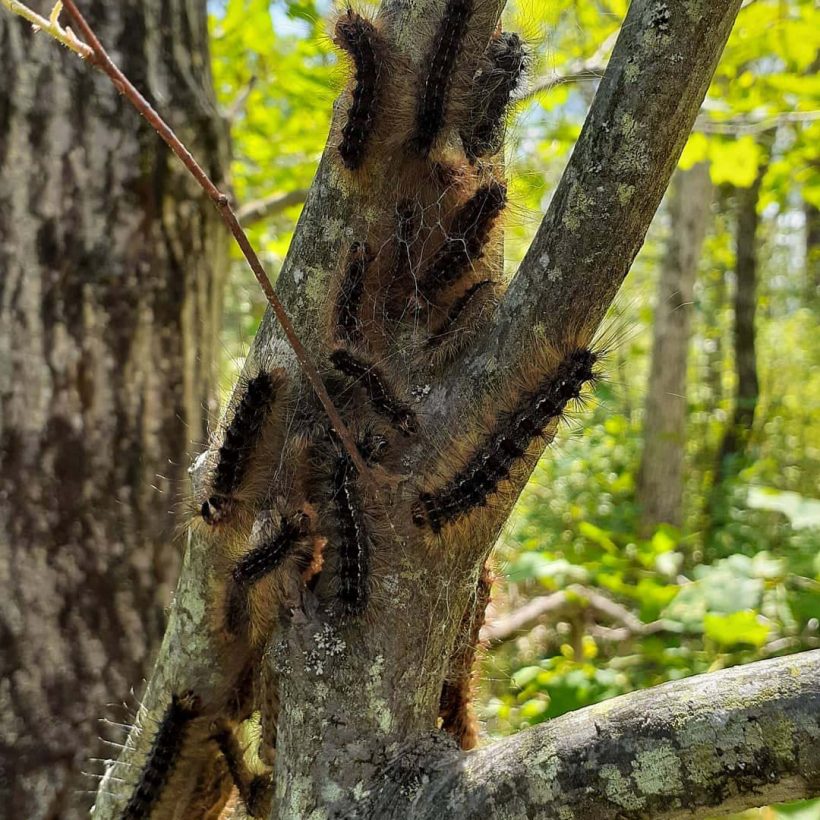GYPSY MOTHS
I recall Doug Thain of Lakeside Forestry calling me last year (see article below) concerned about the army of Gypsy moth caterpillars defoliating the forests along the Sandy Bay road. Although the Covid-19 virus prevented us getting together he did send photos and a video of these destructive consumers in action.
An invasive insect the European Gypsy Moth came to North America in 1869 courtesy of a French naturalist who was attempting to cross it with North American silkworms to create a silk industry. It has since spread from Massachusetts to Ontario arriving in 1969.
Favouring the oak, the larvae will feed on a variety of deciduous and coniferous trees.
You may notice their fuzzy cocoons attached vertically to trees. They become active in late May and June. Their populations are cyclical, peaking every seven to ten years. Hopefully last year (2020) was such a peak year.
Deciduous trees will succumb after successive years of defoliation; coniferous may perish after one serious year of attack. If your trees suffered last season and you notice the cocoons this year you can scrape them off the tree, place them in a jar and soak them in soapy water for two days before disposing of them. In late April, once they have hatched, you can put a barrier around a tree such as tin foil to prevent them from climbing back up. The caterpillars climb to the tree tops to feed in the canopy at night, safe from predators, and then descend to hide during the day.
The Gypsy moth is NATURALLY vulnerable to a Baculovirus that melts the caterpillar from the inside out causing them to drip from the trees and infect other caterpillars feeding beneath.
THE GYPSY MOTH
Doug Thain, of Lakeside Forestry and Property Management, called to advise me that the Sandy Bay Road area is being heavily infested with the Gypsy Moth. “It’s defoliating the oaks and moving to the pine trees!” (See Doug’s photo.)
The European Gypsy Moth is yet another invasive introduced into Massachusetts in 1869 by a French naturalist who was attempting to cross it with North American silkworms to create a silk industry.
The Gypsy moth caterpillars eat the leaves from mostly host hardwoods including oak, birch, poplar, willow, maple and more. Besides white pine and cedar, it will also consume spruce and hemlock needles. Apparently it doesn’t favour ash or tulip poplar. In what is referred to as an ‘outbreak year’ nearly all broadleaf trees may be completely stripped and caterpillar droppings, called “frass”, will rain down from the trees.
The eggs hatch between late April and mid-May. The larval (caterpillar) stage lasts about 7 weeks and during this ravenous stage it gobbles up the tree leaves. The caterpillars can grow to be 6 cm (about 2 ¼ “) and are identified by their bristles and a double row of blue and red dots along their backside. The caterpillars climb to the tree tops to feed in the canopy at night safe from predators then descend to hide during the day.
The adults, which do not eat, live for two weeks during which the males fly about relentlessly pursuing the females being attracted by their pheromones. The females lay between 600-1000 eggs in a compact tear-dropped shape mass of eggs and silk which they place in the open, under bark, on the side of houses, under eaves…. Each female produces but once. Males not so. Then both adults simply die.
Jim McCready is a forester with nearly half a century of experience. “We had the forest tent caterpillar. Now we’ve got the Gypsy moth. And you’ve got drought. We’re getting hammered.” He added that this year’s Gypsy moth hatch is as bad as the peak of this destructive pest in the late 1980’s. This invasion covers a territory ranging from Bancroft to Belleville and north to Mattawa.
The Gypsy moth is vulnerable to a Baculovirus that melts the caterpillar from the inside out causing them to drip from the trees and infect other caterpillars feeding beneath.
To report Gypsy moth sightings call the Invading Species Hotline (1.800.563.7711) or email: info@invadingspecies.com.
